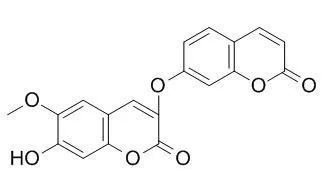| Oncol Lett. 2014 Sep;8(3):1139-1142. |
| Effect of daphnoretin on the proliferation and apoptosis of A549 lung cancer cells in vitro.[Pubmed: 25120673] |
Daphnoretin is an active constituent of Wikstroemia indica C.A. Mey., which is widely distributed in the northwest and southwest regions of China. Previous studies have shown that Daphnoretin has anticancer effects on leukemia, osteosarcoma and uterine cervix cancer cells. However, the effect of Daphnoretin on human lung cancer cells has yet to be elucidated.
METHODS AND RESULTS:
In the present study, Daphnoretin was observed to inhibit A549 lung cancer cell proliferation in a concentration- and time-dependent manner. Fluorescent microscopy and flow cytometric analysis showed that Daphnoretin induced A549 cell apoptosis in a concentration-dependent manner. Western blot analysis also revealed that Daphnoretin induced apoptosis through the regulation of the B-cell lymphoma-2 gene family in A549 cells.
CONCLUSIONS:
These findings indicate that Daphnoretin may have potential as a therapeutic agent for the management of lung cancer. |
| Molecules. 2012 Jan 9;17(1):598-612. |
| Daphnoretin induces cell cycle arrest and apoptosis in human osteosarcoma (HOS) cells.[Pubmed: 22231496] |
In this study antiproliferation, cell cycle arrest and apoptosis induced by Daphnoretin in human osteosarcoma (HOS) cells were investigated.
METHODS AND RESULTS:
Antiproliferative activity was measured with the 3-(4,5-dimethylthiazol-2-yl)-2,5-diphenyltetrazolium bromide (MTT) assay. The IC(50) value of Daphnoretin was 3.89 μM after 72 h treatment. Induction of apoptosis was evidenced by apoptotic body appearance and Annexin V-FITC/PI apoptosis detection kit. Flow cytometric analysis indicated Daphnoretin arrested the cell cycle in the G2/M phase. Western-blot assay showed that the G2/M phase arrest was accompanied by down-regulation of cdc2, cyclin A and cyclin B1. Moreover, Daphnoretin inhibited Bcl-2 expression and induced Bax expression to desintegrate the outer mitochondrial membrane and causing cytochrome c release. Mitochondrial cytochrome c release was associated with the activation of caspase-9 and caspase-3 cascade.
CONCLUSIONS:
Our results demonstrated that Daphnoretin caused death of HOS cells by blocking cells successively in G2/M phases and activating the caspase-3 pathway. |
| Phytother Res. 2010 May;24(5):657-61. |
| Antiviral activity of daphnoretin isolated from Wikstroemia indica.[Pubmed: 19610034] |
METHODS AND RESULTS:
The ethanol extract of Wikstroemia indica was fractionated with organic solvents of different polarities, and various fractions were screened for their antiviral activity against respiratory syncytial virus (RSV) using a cytopathic effect (CPE) reduction assay. The ethyl acetate fraction was most active against RSV with 50% inhibition concentration (IC(50)) value < 3.9 microg/mL and a selectivity index (SI) > 64.1. Further isolation and purification of the fraction led to a purified compound, Daphnoretin. Daphnoretin was tested for its anti-RSV activity using a plaque reduction assay and found active against RSV, with an IC(50 )value of 5.87 microg/mL and SI value of 28.17.
CONCLUSIONS:
The mode of antiviral action study revealed that Daphnoretin could slightly inhibit the early events of the viral infection but its effect was mainly on the later phase of the replication cycle. |






 Cell. 2018 Jan 11;172(1-2):249-261.e12. doi: 10.1016/j.cell.2017.12.019.IF=36.216(2019)
Cell. 2018 Jan 11;172(1-2):249-261.e12. doi: 10.1016/j.cell.2017.12.019.IF=36.216(2019) Cell Metab. 2020 Mar 3;31(3):534-548.e5. doi: 10.1016/j.cmet.2020.01.002.IF=22.415(2019)
Cell Metab. 2020 Mar 3;31(3):534-548.e5. doi: 10.1016/j.cmet.2020.01.002.IF=22.415(2019) Mol Cell. 2017 Nov 16;68(4):673-685.e6. doi: 10.1016/j.molcel.2017.10.022.IF=14.548(2019)
Mol Cell. 2017 Nov 16;68(4):673-685.e6. doi: 10.1016/j.molcel.2017.10.022.IF=14.548(2019)